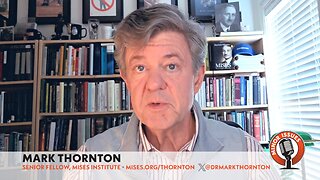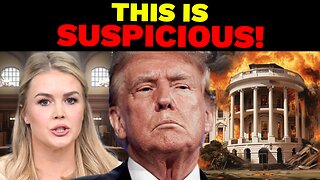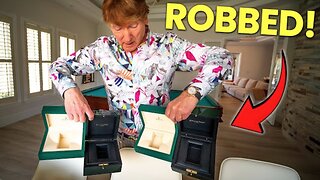Premium Only Content

The Fall of the Gold Standard
At the start of the Federal Reserve, very little changed for average Americans. Over time, an ounce of gold had become valued at $20, which itself was still worth an ounce of silver.
The eruption of World War I changed the world forever.
As we have seen, governments have viewed the printing of money as a convenient means to raise government revenue—particularly in times of war. The incredible costs of World War I quickly forced European central banks to end currency exchanges to gold.
As a result, after the war, European currencies found themselves being valued far less than they were previously. The British pound, for example, was traditionally defined at a weight that made it equal to $4.86. After the war, it was valued at $3.50.
The proper solution to this issue would have been to readjust the pound's peg to gold at this new postwar level. Instead, the British government tried to force the pound to its prewar strength, which would have required a massive reduction of the money supply. Given that prices—including salaries—had now adjusted to the current pound, this was highly disruptive.
The result was global economic instability, contributing to the financial crisis around the world in the twenties and thirties.
In America, President Franklin Delano Roosevelt's response to the Great Depression was an aggressive use of government power. The creation of new government programs, bureaucracies, and public works required levels of spending far beyond anything seen during World War II. Since the government does not create anything on its own and taxing is difficult during a depression, the Federal Reserve was a major tool of the state.
This was made easier in 1933, when FDR announced Executive Order 6102, which said Americans would no longer be able to trade in their dollars for gold and that all privately owned gold was to be confiscated. This allowed FDR to immediately devalue the dollar—an unprecedented transfer of wealth away from Americans and into government.
Agents of major central banks gathered in Bretton Woods, New Hampshire, and adopted a new gold exchange standard.
This Bretton Woods system worked as follows.
The US remained on the classical gold standard, redeeming dollars in gold. British pounds and other currencies were not payable in gold coins, but only in large-sized bars, suitable only for international transactions. This prevented the ordinary citizens from using gold in their daily lives and empowered governments to accept a wider degree of paper and bank inflation—which they did.
The following decades saw many of FDR's radical expansions of government power made permanent and then expanded. This was coupled with a growing American military footprint, with wars in Korea and Vietnam—and military bases established around the world.
This continued increase in spending both domestically and abroad resulted in severe inflation beginning in the 1960s. This led foreign countries to consider exchanging their dollars for gold, as was still allowed. In response, the American government cut the dollar from its last tie to gold in 1971, under Richard Nixon.
For the past fifty years, the world government has been engaged in a radical experiment with global currencies backed by nothing but the credibility of their issuing central bank. Understanding the consequences of this modern fiat money system is one of the most important economic issues in the world today.
________________________________________
This series was inspired by Murray Rothbard's classic introduction, What Has Government Done to Our Money?—available for free in PDF, ePub, HTML, and Audiobook at https://Mises.org/WHGD
To learn more about the operations of the Federal Reserve, check out Bob Murphy's book, Understanding Money Mechanics, available for free in PDF, ePub, and HTML at https://Mises.org/BobMoney
For more animated content, check out Economics for Beginners at https://BeginEconomics.org.
-
 16:53
16:53
Mises Institute
10 days ago $0.03 earnedFree Trade in the Twenty-First Century | Mark Thornton
1872 -
 2:39:40
2:39:40
TimcastIRL
6 hours agoTrump To Impose 104% TARIFF On China At Midnight In NUCLEAR BOMB On Global Trade | Timcast IRL
218K104 -
 1:54:27
1:54:27
Glenn Greenwald
9 hours agoAs Tariffs Dominate News, Trump and Netanyahu Make Increasingly Militaristic Threats; Plus: Mixed Supreme Court Ruling on Deportation Powers | SYSTEM UPDATE #435
145K121 -
 1:01:27
1:01:27
Man in America
9 hours agoMAHA Feels Betrayed by RFK Jr.—What's REALLY Happening? w/ Sayer Ji
50K46 -
 1:15:15
1:15:15
Savanah Hernandez
6 hours agoToxic Empathy Is Ruining America
46.2K39 -
 1:39
1:39
Stephen Gardner
10 hours ago🚨BREAKING: Karoline Leavitt MAKES STUNNING announcement about Trump's Assassin!
44.7K20 -
 1:32:10
1:32:10
Joker Effect
5 hours agoRumble is about to get a new genre!! Are you ready to take it on? Time to fight fire with fire!
46.6K1 -
 3:27:44
3:27:44
SilverFox
5 hours ago🔴LIVE - ELDEN RING - ZERO DEATH CHALLENGE - ATTEMPT 5
33.9K -
 17:17
17:17
SantaSurfing
8 hours ago4/8/2025 - Modern Day Wealth Managers! The Rewards of planning and dreaming big!
41.3K16 -
 26:40
26:40
Producer Michael
12 hours agoI WAS ROBBED IN MY NEW HOUSE!
39.7K2